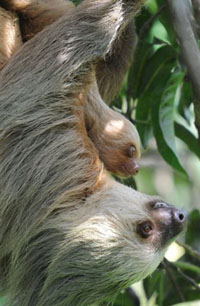What Is a Sloth?

Sloths are the six species of medium-sized mammals belonging to the families Megalonychidae and Bradypodidae, part of the order Pilosa. They are arboreal residents of the rainforests of Central and South America. In Brazil, sloths are commonly called "Bicho-preguiça" ("lazy animal") because of slow movements related to their very low metabolism.
The sloth is the slowest mammal on Earth. It takes a month for a sloth to move 1 kilometer! Sloths are arboreal animals, which means that they spend most of their lives hanging upside-down from tree branches. They eat, sleep, mate, and give birth upside-down in the trees. They only rarely venture to the ground and walk on the ground in an upright position. They sleep about 15 to 18 hours each day.
There are two species of sloths: two-toed and three-toed. Most sloths are about the size of a small dog and they have short, flat heads. Their hair is grayish brown but, at times they look grey-green in color because they move so slowly that tiny camouflaging algae grow all over their coats.
Sloths are plant-eaters who are more active at night; they eat leaves, including leaves from the cecropia tree, tender young shoots, and fruit. They have a low metabolic rate and a low body temperature (91°F). This allows them to eat very slowly (and only need a little bit of food), and they don't require much water, because they don't expend much energy. It takes nearly a week for a sloth to digest one meal.
|